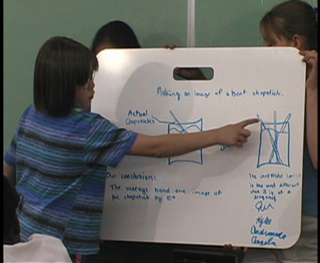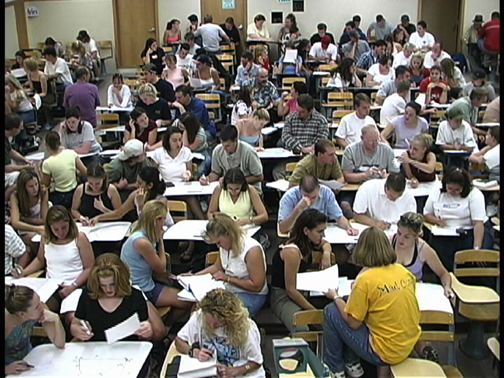Thought
is not merely expressed in words; it comes into existence through
them.
Lev
S. Vygotsky, Thought and Language, 218.
|
 |
What are Whiteboards?
- 32" x 24" pieces of white tile board
- written on with dry erase markers, cleaned with
paper napkins
- 6 boards from a 4' x 8' sheet @$2
- Playscapes (800) 248-7529 @$8
- described in 1995 AJP Modeling Physics article
by Wells, Hestenes and Swackhamer
- foster student collaborative learning in groups
by 'anchoring student dialogue in a concrete artifact'
(D. Hestenes, private communication)
|
|
Why should I use whiteboards?
- provide a concrete venue to ground student discussion
of experiments and problems
- foster student dialog by providing venue, expectations,
opportunity as regular classroom practice
- foster alternative representations of problems
by sketches, graphs, system maps, motion diagrams, pie charts,
equations, etc.
- greatly increase student dialog; use class
time to discuss ideas rather than present them and to think math
and science rather than watch it done
|
|
- engage students in a collaborative learning
community
- practice step-by-step problem solving strategies;
to present, explore, critique and check one another's work during
this process
|
 |
More theoretical reasons for using whiteboards:
- promote strongly coherent conceptual understanding
while decreasing traditional lecture
- use collaborative learning opportunities for
students to teach one another, practice using the language of
the science to one another, develop personal meaning
- recognize and elicit student prior knowledge
and preconceptions, having students articulate and then explicitly
challenging their existing conceptual knowledge structures (and
fostering recognition that these structures are being challenged)
|
- place exploration before formal presentation
- engage students in divergent, student-directed
discourse with one another and with instructors
- encourage student conjecture, alternate solution
strategies and evidence interpretation
|
|
How can teachers guide Whiteboarding groups as they work? (Socratic
interaction)
- watch group composition (groups of
three; mix ability levels; no fewer than two girls; assign rotating
roles such as manager, scribe, critic). Monitor frustration level
(thinking is hard work, but anger impedes learning).
- invoke the advanced student thought that comes
from using language to better articulate the problem
-Tell me what you are doing now
- Tell me what have you done so far
- Why are we doing this this way?
- Teacher reads back student responses without
answering them. Have students confirm, enrich or paraphrase your
restatement.
- So you say... Is this correct?
- How does this relate to the underlying science (mathematics)?
- Where should we go from here?
- groups will often answer their own questions
as they go through the above interaction
- perhaps refer one group to another group that
has solved the problem
- confirm ideas or conjectures from students
that have been moving along fruitful paths, with lots of praise
for students who have the right idea (Eg: Listen to Julie.
Say that again, Julie.)
- when dialog has changed direction in any group
it is time to move on. Your job is to keep dialogue flowing and
fruitful. Students can leave class not knowing the answer yet;
closure should focus the days activity without short circuiting
student thought.
- saying the right answer is never enough. Explaining
the process completes the answer. E.g, why is the accepted answer
preferable?
|
|
How do I grade Whiteboards?
- coarse scaled group grade (0 - 5 pts) for
quality of board, clarity of presentation, responses to questions;
no grade for being right or wrong at this point
- bonus pts for good questions from student
- small group grade percentage; larger individual
grade for content understanding on a later, formal test or exam
for student correctness
- extensive discussions of grading rubrics whiteboards
for HS physics and chemistry at http://modeling.la.asu.edu/
|
|
What are the issues arising from Whiteboard use?
- highly constructivist, national standards
(inquiry) driven activity (See NSES Standard #1). Whiteboard use
fosters the following Arizona
Professional Teaching Standards: Standards 1.4-9,11; 2.1,3-8;
3.3-9,11-13,15; 4.1,2
- less material is 'covered' in greater depth;
greater retention and less review results. Teachers must know
the district and state standards, and work them into activity
agenda
- students practice valuable critical thinking,
collaborative interaction and presentation skills that are sought
by employers, medical colleges etc. Teacher and students work
together to improve understandings; teacher is not necessarily
a subject expert
- used at NAU, ASU; Maricopa Community Colleges;
HS modeling physics & chemistry students nationwide; K-12
science and math students in Flagstaff Unified School District
- teachers must have courage to allow students
to realize they must ultimately be accountable for their own learning,
and let them do so. Whiteboarding classes are nontraditional,
inquiry-oriented classes that de-emphasize didactic lecture, fact
memorization, and closure; emphasize student-student and student-teacher
discourse and student initiative
- some students will resist inquiry teaching;
it is easier to memorize and regurgitate facts or plug-and-chug
formulas than to understand. Thinking is hard work. Anticipate
some student reaction, and foster student reflection on their
own learning to explicitly recognize growth in their reasoning
ability
|
Arons, A.B. (1997). Teaching introductory physics. Wiley: NY.
Falconer, K.F., Joshua, M. & Desbien, D. (2002) RTOP Video 4: Modeling
physics circle white board discourse (23MB quicktime movie). http://physicsed.buffalostate.edu/rtop/videos/RTOP4/RTOP4play.html
Hake, R. R. (1996). Evaluating conceptual gains in mechanics: A six-thousand-student
survey of test data. Proceedings of the third international conference
on undergraduate physics education, College Park, MD.
Hake, R. R. (1998). Interactive-engagement versus traditional methods:
A six-thousand-student survey of mechanics test data for introductory
physics courses. American Journal of Physics, 66, 64-74.
Hake, R.R. (1992). Socratic pedagogy in the introductory physics lab.
Physics Teacher, 30, 546-552.
Hestenes, D. (2000). Private communication.
MacIsaac, D.L. (2000). Active Engagement, Cooperative Learning in Large
Enrollment Introductory College Physics Lectures for Preservice Teachers.
NSF Collaboratives for Excellence in Teacher Preparation (CETP) conference.
http://physicsed.buffalostate.edu/pubs/CETP/
Rader, J. L. (2000) Private communication.
Sawada, D., Piburn, M., Falconer, K., Turley, J. Benford, R., Bloom, I.
(2000). Reformed Teaching Observation Protocol (RTOP). ACEPT IN-01, http://physicsed.buffalostate.edu/pubs/RTOP/
.
Sawada, D. and Piburn, M. (2000). Reformed Teaching Observation Protocol
(RTOP) Training Manual. ACEPT IN-02, http://physicsed.buffalostate.edu/pubs/RTOP/
.
Vygotsky, L.S. (1997). (Revised and edited, A. Kozulin). Thought and language.
MIT: Cambridge.
Wells, M., Hestenes, D. & Swackhamer, G. (1995). A modeling method for
high school physics instruction. American Journal of Physics, 64,
114-119.
|

